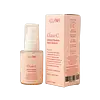What's inside
What's inside
 Key Ingredients
Key Ingredients

 Benefits
Benefits

 Ingredients Side-by-side
Ingredients Side-by-side

Water
Skin ConditioningSodium Ascorbyl Phosphate
AntioxidantSodium Lactate
BufferingSodium Glutamate
MaskingGlycyrrhiza Glabra Root Extract
BleachingZiziphus Jujuba Fruit Extract
Skin ConditioningArtemisia Capillaris Flower Extract
Skin ConditioningScutellaria Baicalensis Root Extract
AstringentMorus Alba Root Extract
BleachingPunica Granatum Flower Extract
Skin ConditioningSodium Hyaluronate
HumectantButylene Glycol
HumectantXanthan Gum
EmulsifyingMaltodextrin
AbsorbentEthylhexylglycerin
Skin ConditioningPhenoxyethanol
PreservativeSodium Citrate
BufferingWater, Sodium Ascorbyl Phosphate, Sodium Lactate, Sodium Glutamate, Glycyrrhiza Glabra Root Extract, Ziziphus Jujuba Fruit Extract, Artemisia Capillaris Flower Extract, Scutellaria Baicalensis Root Extract, Morus Alba Root Extract, Punica Granatum Flower Extract, Sodium Hyaluronate, Butylene Glycol, Xanthan Gum, Maltodextrin, Ethylhexylglycerin, Phenoxyethanol, Sodium Citrate
Water
Skin ConditioningNiacinamide
SmoothingButylene Glycol
HumectantGlycerin
HumectantTranexamic Acid
AstringentInositol
HumectantArbutin
AntioxidantUndecylenoyl Phenylalanine
Skin ConditioningSodium Hyaluronate
HumectantYeast Ferment Extract
Skin ConditioningTocopherol
AntioxidantCarbomer
Emulsion StabilisingHydroxyethylcellulose
Emulsion StabilisingTriethanolamine
BufferingPhenoxyethanol
Preservative1,2-Hexanediol
Skin ConditioningEthylhexylglycerin
Skin Conditioning
 Reviews
Reviews

Ingredients Explained
These ingredients are found in both products.
Ingredients higher up in an ingredient list are typically present in a larger amount.
Butylene Glycol (or BG) is used within cosmetic products for a few different reasons:
Overall, Butylene Glycol is a safe and well-rounded ingredient that works well with other ingredients.
Though this ingredient works well with most skin types, some people with sensitive skin may experience a reaction such as allergic rashes, closed comedones, or itchiness.
Learn more about Butylene GlycolEthylhexylglycerin (we can't pronounce this either) is commonly used as a preservative and skin softener. It is derived from glyceryl.
You might see Ethylhexylglycerin often paired with other preservatives such as phenoxyethanol. Ethylhexylglycerin has been found to increase the effectiveness of these other preservatives.
Phenoxyethanol is a preservative that has germicide, antimicrobial, and aromatic properties. Studies show that phenoxyethanol can prevent microbial growth. By itself, it has a scent that is similar to that of a rose.
It's often used in formulations along with Caprylyl Glycol to preserve the shelf life of products.
Sodium Hyaluronate is hyaluronic acid's salt form. It is commonly derived from the sodium salt of hyaluronic acid.
Like hyaluronic acid, it is great at holding water and acts as a humectant. This makes it a great skin hydrating ingredient.
Sodium Hyaluronate is naturally occurring in our bodies and is mostly found in eye fluid and joints.
These are some other common types of Hyaluronic Acid:
Learn more about Sodium HyaluronateWater. It's the most common cosmetic ingredient of all. You'll usually see it at the top of ingredient lists, meaning that it makes up the largest part of the product.
So why is it so popular? Water most often acts as a solvent - this means that it helps dissolve other ingredients into the formulation.
You'll also recognize water as that liquid we all need to stay alive. If you see this, drink a glass of water. Stay hydrated!
Learn more about Water